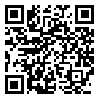دوره 7، شماره 1 - ( 6-1400 )
جلد 7 شماره 1 صفحات 48-39 |
برگشت به فهرست نسخه ها
Download citation:
BibTeX | RIS | EndNote | Medlars | ProCite | Reference Manager | RefWorks
Send citation to:



BibTeX | RIS | EndNote | Medlars | ProCite | Reference Manager | RefWorks
Send citation to:
Akbari Shahrestanaki Y, Moghaddam Zeabadi S, Ziaiha M, Arjeini Z, Hoseinzadeh Khezri R, Rastak S. Admission Indicators for Prehospital Emergency Medical Students. Health in Emergencies and Disasters Quarterly 2021; 7 (1) :39-48
URL: http://hdq.uswr.ac.ir/article-1-383-fa.html
URL: http://hdq.uswr.ac.ir/article-1-383-fa.html
Admission Indicators for Prehospital Emergency Medical Students. فصلنامه سلامت در حوادث و بلایا. 1400; 7 (1) :39-48
چکیده: (4271 مشاهده)
Background: Appropriate and timely response in urgent situations requires vast knowledge and physical and mental preparedness. Since emergency medical technicians are the first professional respondents in the health system, selecting the right people to study in this field is very important. Because there is no specific model in Iran to propose the indicators in the selection of applicants for this field, the present study was conducted to offer some indicators for the admission of prehospital emergency medical students.
Materials and Methods: This research was conducted using a mixed qualitative and quantitative approach in three steps: reviewing the relevant texts, meetings of scientific and operational experts, and determining the validity and reliability of the content. After finalizing, the areas and indicators of student selection were used in the interview process of candidates in 2020. SPSS v. 24 software was used for quantitative data analysis.
Results: The selection tool for prehospital emergency medical students included 4 areas (with 26 criteria): 1) general qualifications area with 8 criteria (documents concerning degree and identity, written GPA of diploma, entrance exam score, type of diploma, special abilities, working in relief organizations, gaining a scientific-sports position, and interviewing of faculty members); 2) physical health with 7 criteria (height, body mass index, visual health, hearing health, stuttering, organ dysfunction-physical disability, and chronic debilitating diseases); 3) psychological status with 5 criteria (orderliness, responsibility, quick and correct decision making, stress management, and belief in teamwork); and 4) physical fitness with 6 criteria (1600-m run, 45-m speed-run, 4×9 m run, sit-up, long jump, and Swedish swimming in 30 s).
Conclusion: Given the vital importance of prehospital emergency medical jobs as the front line of the health system response, selecting the right people will play a significant role in increasing the quality of services provided, increasing patient satisfaction, and ultimately improving health of the community.
Materials and Methods: This research was conducted using a mixed qualitative and quantitative approach in three steps: reviewing the relevant texts, meetings of scientific and operational experts, and determining the validity and reliability of the content. After finalizing, the areas and indicators of student selection were used in the interview process of candidates in 2020. SPSS v. 24 software was used for quantitative data analysis.
Results: The selection tool for prehospital emergency medical students included 4 areas (with 26 criteria): 1) general qualifications area with 8 criteria (documents concerning degree and identity, written GPA of diploma, entrance exam score, type of diploma, special abilities, working in relief organizations, gaining a scientific-sports position, and interviewing of faculty members); 2) physical health with 7 criteria (height, body mass index, visual health, hearing health, stuttering, organ dysfunction-physical disability, and chronic debilitating diseases); 3) psychological status with 5 criteria (orderliness, responsibility, quick and correct decision making, stress management, and belief in teamwork); and 4) physical fitness with 6 criteria (1600-m run, 45-m speed-run, 4×9 m run, sit-up, long jump, and Swedish swimming in 30 s).
Conclusion: Given the vital importance of prehospital emergency medical jobs as the front line of the health system response, selecting the right people will play a significant role in increasing the quality of services provided, increasing patient satisfaction, and ultimately improving health of the community.
| بازنشر اطلاعات | |
 |
این مقاله تحت شرایط Creative Commons Attribution-NonCommercial 4.0 International License قابل بازنشر است. |





